




OVERVIEW
Finding Time: Columbus Public Art 2012, planned in conjunction with 200 Columbus: The Bicentennial, transformed downtown Columbus into an open-air gallery in 2012 and 2013, creating memorable experiences for downtown workers, Columbus residents, and visitors.
The 12 projects of Finding Time involved the work of 50 international, national, and local artists. Individually and collectively, these projects explored the physical and philosophical measurement of time, investigating and questioning the notion of time, while making the City of Columbus aware of passing time, world time, the use of time, the measurement of time, the chronology of a life, and the notions of temporary and permanent.
Finding Time offered 10 temporary public art projects in plazas, parks, streets, and alleys in the downtown core and along the riverfront. Two projects—the book Combing Columbus and the parking lot structures of Bold Booths—extend the life of Finding Time into the future. Three artworks from Finding Time were selected for inclusion in the prestigious Public Art Network Year in Review program, which honors outstanding public art works annually. Candace Black’s Buckle and Nikhil Chopra’s inside out: As the stars viewed the Palace were honored in 2013 and Jon Rubin’s The Time and The Temperature, in 2014.
Perhaps most significantly, Finding Time laid the groundwork for a new level of commitment to public art from the city of Columbus and from civic leaders in the community. The many successful partnerships that fueled the Finding Time’s artworks also offered models for ongoing and future cooperation: between city and county officials, Special Improvement Districts, community agencies, property owners, colleges and universities, arts organizations, and artists. On February 4, 2014, Columbus Mayor Michael B. Coleman signed an executive order to establish an ongoing public art program for the city.
PROJECT DIRECTOR’S INTRODUCTION: THE STORY OF FINDING TIME
In August 2007, I was appointed by Mayor Michael B. Coleman to serve on the newly constituted Columbus Art Commission. The idea for creating this body, it turned out, was not new: legislation was written and passed in 1960 to establish an Art Commission. For reasons that are hard to fathom, it took 47 years and Mayor Coleman to act on the legislation.
The six other commissioners and I learned that our primary role was “to approve all art purchased, commissioned, or accepted as a gift by the City, as well as all art proposed for placement anywhere within the Public Right of Way or on property owned or leased by the City.” We embraced that charge—and at the same time aspired to be more than gatekeepers. Two years into the life of the commission, our desire to do more was reinforced when Mayor Coleman challenged us to be proactive advocates for public art in Columbus and to build community support for public art programming. When the door closed as he left the meeting, we wondered out loud, “How... and with what resources?” Be careful what you wish for.
In early 2010 I noticed the annual call for applications for Engagement/Impact Grants at The Ohio State University, where I was then a professor in the Department of Art (I retired from the university in 2012). The grants were described as “a program to support innovative, creative, and scholarly outreach and engagement initiatives that partner the academic/research excellence of The Ohio State University with communities.” Thus far, community and Columbus Art Commission attempts to advocate for public art by showing PowerPoint presentations and passing out PDFs about public art in other cities had fallen flat. Perhaps we could advocate more effectively by showing rather than telling. Planning for the 2012 bicentennial was in the air, and the other commissioners agreed that it seemed an opportune time to demonstrate the possibilities and benefits of public art, with efforts that might be supported by this competitive grant program. But the art commission had no budget, and a requirement of the OSU grant was to apply with an off-campus partner willing to commit matching funds of 25% of the grant request.
I had met Cleve Ricksecker, executive director of the Capital Crossroads Special Improvement District (SID), in the summer of 2009. Cleve lived up to his reputation as being the go-to guy to locate vacant storefronts and buildings in the downtown in which the 25 students in my graduate studio could do special projects. “Art Squatters,” as the students dubbed the venture, was hugely successful, both for the students and for the downtown. With this experience still fresh in mind, I asked Cleve if the Capital Crossroads SID would be interested in being the off-campus partner for an Engagement/Impact Grant application to support a program of temporary public art in downtown Columbus. The SID Board approved the request in less than a week. We were fortunate to be awarded one of four grants in spring 2010, and the program was launched. To make the proverbial long story short, Finding Time: Columbus Public Art 2012 was the result. The OSU and SID commitments allowed us to assemble a curatorial team, develop a roster of artists to be invited to propose works, and undertake serious fundraising.
Without doubt the most significant fundraising component for Finding Time came through our successful application for a highly competitive Our Town grant from the National Endowment for the Arts (NEA) during the Our Town program’s inaugural year in 2011. This NEA grant program was intended to foster “creative placemaking” by utilizing and leveraging arts and design initiatives to support and sustain the development of dynamic, livable neighborhoods. A key component of the grant program is that each application must come from a partnership of at least two organizations—one a governmental entity and the other a nonprofit cultural or design organization—in order to insure the commitment and leadership necessary for success. We were fortunate that Mayor Coleman endorsed Finding Time as the City of Columbus’s application (each governmental partner could participate in only one) for this prestigious and generous grant program and that our project already had the support of Ohio State and Capital Crossroads, along with several other enthusiastic partners. The formal applicants for the Our Town grant were the City of Columbus and the Greater Columbus Arts Council (GCAC).
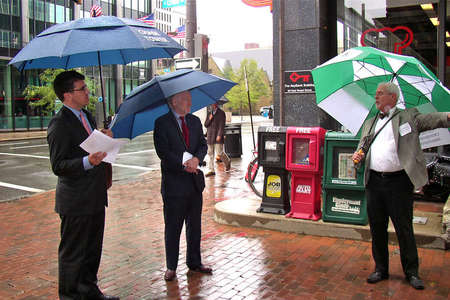
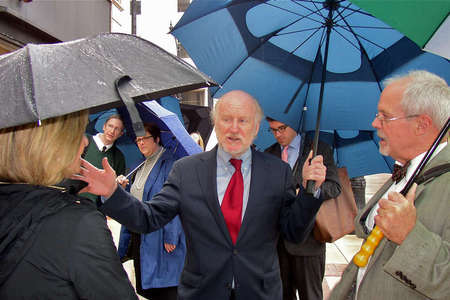
When we received notification in June 2011 that our proposal had been approved for a grant of $150,000, we were able to shift our planning into high gear. An additional boost came in September 2011, when Rocco Landesman, then chairman of the NEA, visited Columbus and toured sites being considered for Finding Time projects with Cleve Ricksecker. In conjunction with his visit, Ohio State’s Wexner Center for the Arts hosted “A Way Forward: Arts and Economic Development,” a panel discussion with Landesman; Mayor Coleman; Leslie H. Wexner, chairman and CEO of Limited Brands (now L Brands); Douglas F. Kridler, president and CEO of The Columbus Foundation; and moderator Julie Henahan, then executive director of the Ohio Arts Council. This high-profile discussion of the value of the creative sector in building competitive, lively cities was evidence of the growing awareness of the significant role of the arts in greater Columbus.
Our curatorial vision was to treat downtown as an open-air gallery that would create memorable experiences for downtown workers, residents, and visitors. We wanted to reflect the broad range of approaches, forms, and media in contemporary public art. We were dead set against limiting projects to a particular location such as a park or only along the riverfront, yet we recognized that it would be a mistake to spread things too thin. The program boundaries, we decided, would be Spring Street to the north, Main Street to the south, COSI (Columbus’s popular science museum center) to the west, and the Columbus Metropolitan Library on S. Grant Avenue to the east.
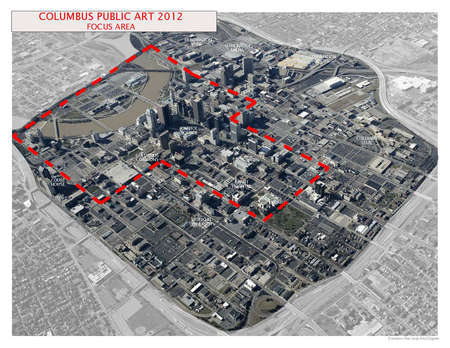
Defining the physical site, however, was not enough to shape the program. The curatorial team identified the overarching theme of time, which would dovetail with events being planned by the Columbus Bicentennial Commission to showcase the city’s past, present, and future.
Given the relatively short window in which to develop and realize projects, we determined that participation would be by invitation. The curatorial team developed our roster of international, national, and local artists from our own professional contacts and from suggestions made by colleagues and others in the field. Curator and program consultant Shelly Willis’s familiarity with artists who create for public places was particularly crucial in developing our list of participants. She drew our attention to Janet Zweig, Stuart Williams, David Best, and Jon Rubin. Martin Keil and Henrik Mayer (Reinigungsgesellschaft) and Nikhil Chopra came to mind as possible international artists because of previous connections with Columbus. Our choices locally included artists who had proven track records, along with some who we felt were ripe for their first opportunity to work in the public realm. Dow Kimbrell’s connections to the local architectural community were valuable for the Bold Booths project. The Columbus jazz musicians and contemporary composers whom we initially approached about the chime project helped us secure the 12 individuals who wrote for the bells at Trinity Episcopal Church.
Once artists were identified, they were invited to select sites in the program area and to respond to the general context of the downtown and to the overarching theme of time. Our initial thought was that all the projects would be temporary, although that also evolved. The budgets were consistently modest; we hoped and planned to stretch what funds we could raise.
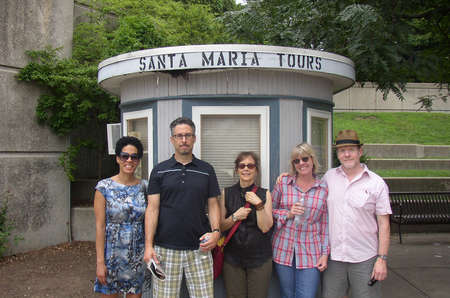
What, we wondered, would the artists come up with? Answers to that question ranged from the familiar—sculpture, drawing, and painting—to forms that perhaps raised eyebrows or caused viewers to query, “Why is this art?” We knew that public art need not be relegated to decoration. In keeping with that proposition, some Finding Time projects were readily understood, but others inspired wonder or raised questions. Many required reflection and time—our operative word—to be appreciated. We aimed not to emulate what other cities had done but to capitalize on sites and resources unique to our downtown.
In the end, the 12 projects of Finding Time involved the work of 50 artists. Ten projects in plazas, parks, streets, and alleys in the downtown core and along the riverfront were temporary, in keeping with the original plans. Two projects—the book Combing Columbus and the parking lot structures of Bold Booths—extend the life of Finding Time into the future. Inevitably, some aspects of Finding Time did not go exactly as planned. We were able to realize almost all of the planned projects during 2012, but a few spilled over into 2013. Unexpected delays in obtaining required permits held up the installation of Jon Rubin’s The Time and The Temperature until January 2013. An unanticipated and protracted review process required by the Army Corps of Engineers (which has oversight responsibility for the Scioto River) delayed the presentation of Tim Reitenbach’s Grazing until June 2013. Mary Jo Bole’s Combing Columbus was published in 2013, serving perhaps as a kind of commemorative tribute to the city’s bicentennial celebrations of the previous year. When time and funding limitations kept the ambitious designs of the Bold Booths from being built under the auspices of Finding Time, the Capital Crossroads SID and the architects involved decided to continue pursuing the project independently.
In addition to the works themselves, Finding Time offered numerous occasions for public interaction and for education and advocacy about the possibilities of public art. We organized a number of public gatherings, including informal “openings” to celebrate the completion of artworks and on-site artist talks, and these events are listed in many of the “Project Details” sections of this website.
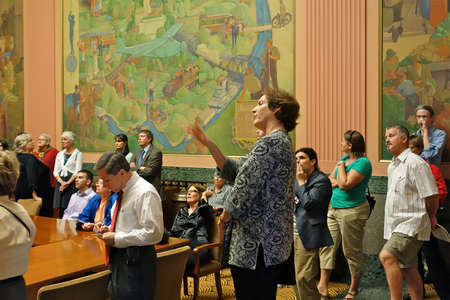
To provide historical perspective on public art, we also organized two tours of the Ohio Judicial Center, a superb example of the integration of art and architecture in the public realm from the early 1930s. In November 2012 we hosted “Looking Ahead: A Forum on Public Art in Columbus” at the Columbus Museum of Art with Jason Schupbach, director of design for the NEA, as our keynote speaker. In one session, speakers from Kansas City (MO), Cleveland (OH), and Portland (OR) joined Finding Time curator Shelly Willis, from Sacramento (CA), to discuss public art programs and practices in their cities. In another session, which I moderated, artists Janet Zweig and Jon Rubin and architects Beth Blostein and Bart Overly talked about their projects for Finding Time and shared insights from their experiences in Columbus and elsewhere.
At the start of this venture it was impossible to imagine the collective resources and energy that it would require. Throughout, we were buoyed by the support of local, state, and national organizations and agencies. Private donors also gave generously. The level of cooperation and collaboration from project partners was remarkable. City commissions and departments rose to the occasion as we figured out together how to make public art happen in Columbus. The lists in the Partners section of this website can only begin to convey our gratitude to the countless individuals and organizations that came together to make Finding Time a reality.
Looking back and taking stock, those of us most closely involved in organizing Finding Time are frankly amazed by the works that were created and by the enthusiasm of artists, collaborators, partners, and the public. We are gratified by the scope and quality of the program, by the partnerships formed across the city, and by the enthusiasm for public art that the Finding Time program has inspired. Perhaps most importantly, Finding Time forged relationships with city, county, and other agencies, institutions, and officials whose support and cooperation will be critical to the success of future public art in Columbus. And we are pleased and proud that three of the projects received national awards and that, in the aftermath of Finding Time and perhaps bolstered by its example, Columbus has an ongoing public art program.
Malcolm Cochran
Program Director and Curator
November 2014
This text is adapted, expanded, and updated from the Introduction to the printed catalog of Finding Time: ColumbusPublicArt2012.
CURATORS & PRINCIPAL PARTNER
SECIAL THANKS
LINKS
RELATED EVENTS
PRESS
OTHER

